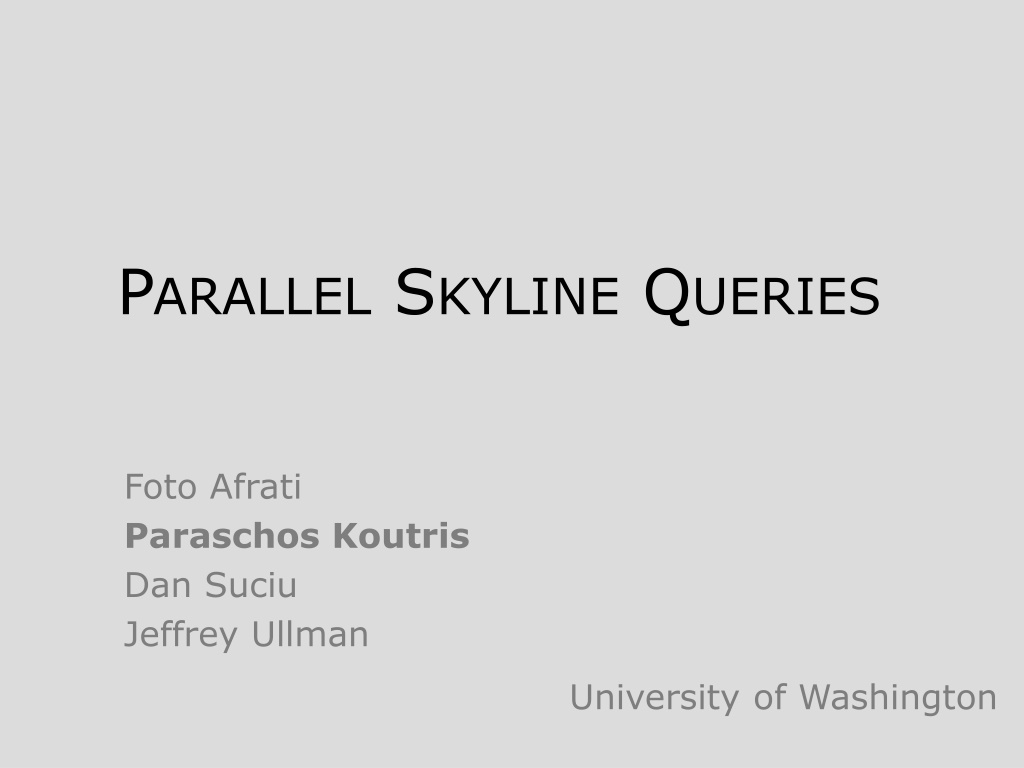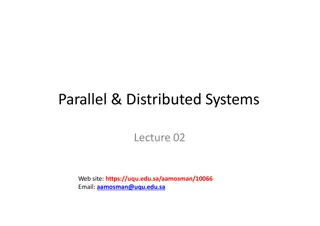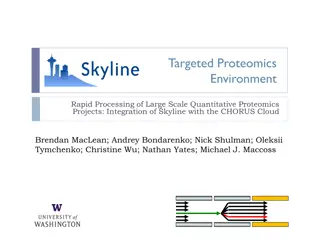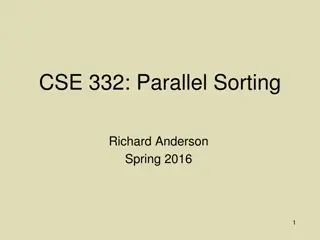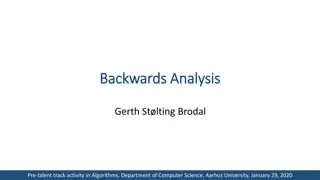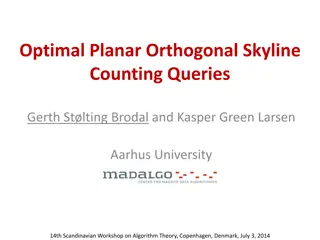Understanding Parallel Skyline Queries in Distributed Systems
Explore the concept of skyline queries in parallel computing, focusing on non-dominated points in a d-dimensional set. Learn about efficient algorithms, massively parallel models, communication strategies, and the application of broadcast steps. Enhance your knowledge of skyline computation processes through detailed explanations and visual representations.
Download Presentation

Please find below an Image/Link to download the presentation.
The content on the website is provided AS IS for your information and personal use only. It may not be sold, licensed, or shared on other websites without obtaining consent from the author. Download presentation by click this link. If you encounter any issues during the download, it is possible that the publisher has removed the file from their server.
E N D
Presentation Transcript
PARALLEL SKYLINE QUERIES Foto Afrati Paraschos Koutris Dan Suciu Jeffrey Ullman University of Washington
WHATIS THE SKYLINE? A d-dimensional set R A point x dominates x if forall k: x(k) x (k) The skyline of R are all non-dominated points of R skyline domination 2
CONTRIBUTIONS We design algorithms for Skyline Queries based on two parallel models: MP: perfect load balancing [Koutris, Suciu 11] GMP: weaker load balancing [Afrati, Ullman 10] We present 3 algorithms with theoretical guarantees for: # synchronization steps load balance 3
PREVIOUS APPROACHES Several efficient algorithms for skyline queries exist in the literature Parallel algorithms use various partitionings: Grid-based partitioning [WZFZAA 06] Random partitioning [CRZ 07] Angle-based space partitioning [VDK 08] Hyperplane projections [KYZ 11] Previous approaches typically require a logarithmic number of communication steps: our algorithms achieve 1 or 2 steps 4
MASSIVELY PARALLEL MODELS P servers: R partitioned into R1,R2, , RP n = |R| The algorithm alternates between communication and computation steps MP model: each node holds O(n/P) data GMP model: each node holds O(P * n/P) where 0 < 1 = 0 : GMP = MP = 1 : GMP = sequential computation in one node 5
AN EXAMPLE How do we compute set intersection in one step in the MP model? Hash each value x (from R or S) to a server Intersection Q(x):-R(x),S(x) Communication Phase send tuple R(x) to server @h(x) send tuple S(x) to server @h(x) Computation Phase output a tuple only if it occurs twice 6
THE BROADCAST STEP In addition to regular communication steps, we allow broadcast steps: the data exchanged is independent of n Known results: Q(x,y)=R(x),S(x,y) can be computed in 1 MP step iff a broadcast step is allowed [Koutris, Suciu 11] Q(x,y)=R(x),S(x,y),T(y) can not be computed in 1 MP step [Koutris, Suciu 11] , but can be in 1 GMP step with =1/2 [Afrati, Ullman 10] 7
OUTLINEOFOUR APPROACH Broadcast Grid-based partitioning into cells Pre-processing the cells to compute the relaxed skyline Communication Careful distribution of the cells (with their data) to the servers Computation: Local computation of the skyline at each server 8
Algorithm: Local: each server evenly partitions its data to M buckets Broadcast: servers exchange MxP partition points Local: each server picks every P-th value as partition point BUCKETIZING Partition Rinto M buckets across some dimension, such that each partition contains O(n/M) points Equivalently, compute (M+1) partition points: - = b0 , b1, , bM= + M=P or P1/(d-1) bucketize across dimension 1 bucketize across dimension 2 9
CELLS A cell is an intersection of buckets from all dimensions Every point belongs in exactly one cell Every cell holds O(n/P) data (and not O(n/Pd) !!) In each cell, we can keep only candidates for skyline points candidate rejected 10
OUTLINEOFOUR APPROACH Broadcast Grid-based partitioning into cells Pre-processing the cells to compute the relaxed skyline Communication Careful distribution of the cells (with their data) to the servers Computation: Local computation of the skyline at each server 11
CELLS We are interested in the non-empty cells Any cell that is strictly dominated by another does not contribute to the skyline no points belong in the final skyline strict domination domination 12
RELAXED SKYLINEOF CELLS The relaxed skyline consists of the non-empty cells that are not strictly dominated by non-empty cells We focus on the relaxed skyline of non-empty cells relaxed skyline skyline 13
ON RELAXED SKYLINES To compute the skyline points of a cell B, we need to compare with cells that: belong in the relaxed skyline weakly dominate B (have one common coordinate) cell B 14
OUTLINEOFOUR APPROACH Broadcast Grid-based partitioning into cells Pre-processing the cells to compute the relaxed skyline Communication Careful distribution of the cells (with their data) to the servers Computation: Local computation of the skyline at each server 15
A NAVE APPROACH Try the following: Partition into P buckets (M=P) Allocate cells in the relaxed skyline to servers + cells that weakly dominate them: O(n/P) data per cell Locally compute the skyline points This works if the relaxed skyline is small But the relaxed skyline can have as many as (Pd-1) cells for dimension d 16
A 1-STEP ALGORITHM Choose a coarser bucketization (<P buckets) This gives a weak load-balanced algorithm with maximum load of O( (n/P) P(d-2)/(d-1) ) = (d-2)/(d-1) ( =0 implies GMP=MP) Corollary. For d=2 dimensions, we obtain a perfectly load balanced algorithm for MP 17
A 2-STEP ALGORITHM Step 1: group the cells in the relaxed skyline by bucket for every dimension Server 1 Server 2 Server 2 Server 1 18
A 2-STEP ALGORITHM For each bucket, compute the local skyline A point is a skyline point iff it is a local skyline point in every one of the d buckets Step 2: intersect the local skylines This point is in the skyline of the y-bucket, but not the x-bucket x-bucket 19 y-bucket
A 1-STEP ALGORITHMFOR 3D Key idea: to reject this point, we only need the minimum x-coordinate from cell B cell B 20
A 1-STEP ALGORITHMFOR 3D The observation reduces the number of points that need to be communicated With smart partitioning, we can achieve perfect load- balance in 1 step However, the property holds only for 2 and 3 dimensions 21
CONLUSION 3 algorithms for Skyline Queries: 2 step + perfect load balance 1 step + some replication 1 step + perfect load balance for d < 4 Open Questions Can we compute the skyline in 1 step with perfect load balance for >3 dimensions? A more general question: what classes of queries can we compute in the MP model with perfect or weaker load balance guarantees? 22
Thank you! 23
INTERIOR CELLS Two cells are co-linear if they share exactly two coordinates A cell i is interior if every colinear cell in Sr(J) belongs in the same hyperplane as i. Else, it is a corner cell. Interior cells are easy to handle: we can send the whole plane to a single processor 24
CORNER CELLS We group the corner cells into lines Border cells are the minimal/maximal cells of each line Fact: lines meet only on border cells Grouping: each line is a group, a cell is assigned to the lexicographically first line it belongs to 25
Assigning the groups We have two ways to assign groups to servers The first is deterministic and greedily assigns a group to any server that is not overloaded (M=P) The second is randomized and sends each group randomly to some server (M = P log P) 26
About the MP model [KS11] A dichotomy result on Conjunctive Queries that can be computed in 1 step with perfect load balancing Easy Queries: Q(x,y,z) :- R(x,y) , S(y,z) Q(x,y,z,) :- R(x), S(x,y), T(x,y,z) Hard Queries: Q(x,y) :- R(x), S(x,y), T(y) Q(x,y) :- R(x), S(x), T(y) 27
